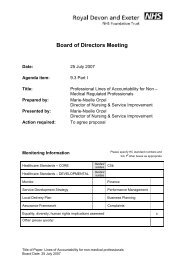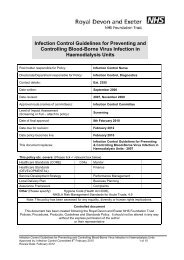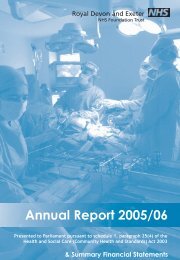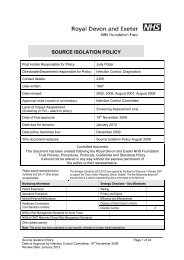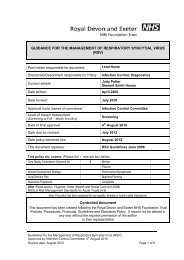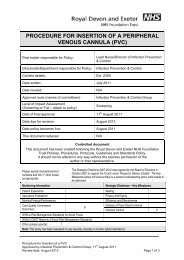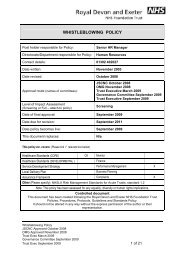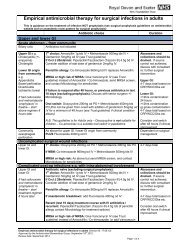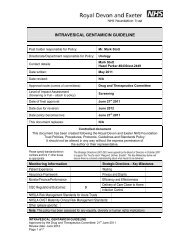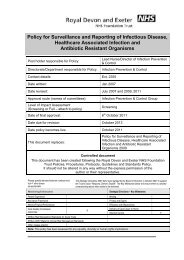Annual Report and Accounts 2012/13 - Royal Devon & Exeter Hospital
Annual Report and Accounts 2012/13 - Royal Devon & Exeter Hospital
Annual Report and Accounts 2012/13 - Royal Devon & Exeter Hospital
You also want an ePaper? Increase the reach of your titles
YUMPU automatically turns print PDFs into web optimized ePapers that Google loves.
52<br />
2. Our Trust <strong>Royal</strong> <strong>Devon</strong> <strong>and</strong> <strong>Exeter</strong> NHS Foundation Trust<br />
<strong>Annual</strong> <strong>Report</strong> <strong>and</strong> <strong>Accounts</strong> <strong>2012</strong>/<strong>13</strong><br />
For the year <strong>2012</strong>-<strong>13</strong> the Trust paid<br />
the following in levies designed to<br />
incentivise low carbon energy usage:<br />
Scheme £<br />
CRC 80,000<br />
CCL <strong>13</strong>5,120<br />
EUETS 0<br />
The Trust has managed to keep its<br />
EUETS emissions within the target<br />
range, so has avoided having to<br />
purchase extra allowances. Cost of<br />
CRC carbon will rise from £12 to<br />
£16 per tonne in 20<strong>13</strong>/14. Based on<br />
2011/12 energy usage this means a<br />
cost increase of £24,384.<br />
The Trust’s building energy carbon<br />
footprint in 2007 was 19,145 tonnes<br />
(April 2007 to March 2008). This is<br />
now regarded as the 2007 baseline<br />
year for the Carbon Reduction Strategy<br />
<strong>and</strong> the Trust’s target is therefore<br />
to reduce its emissions by 10% to<br />
approximately 17,231 tonnes by 2015.<br />
The emissions rose to 20,240 tonnes in<br />
2008/09 due to increase in the Trust’s<br />
activity <strong>and</strong> building size following<br />
the opening of the new Centre for<br />
Women’s Health at Wonford <strong>Hospital</strong><br />
in July 2007. However, in 2009/10<br />
there was a reduction in the Trust’s<br />
building energy carbon emissions to<br />
18,609 tonnes. Although this was<br />
partly due to weather conditions<br />
the Trust was also able to gain more<br />
effective use of its CHP (combined heat<br />
<strong>and</strong> power) installation, generating<br />
electricity on-site <strong>and</strong> producing heat<br />
to create steam for the laundry.<br />
The figures for <strong>2012</strong>/<strong>13</strong> show that<br />
the building energy carbon footprint<br />
is 20,830 tonnes (see Tables 1 <strong>and</strong> 2<br />
below). This is an increase on previous<br />
years. This increase is mainly due to<br />
an increase in patient activity <strong>and</strong> the<br />
CHP plant being under renovation.<br />
The increase in energy usage has been<br />
somewhat muted due to a warmer<br />
than normal winter <strong>and</strong> a cooler than<br />
normal summer, reducing dem<strong>and</strong><br />
on boilers <strong>and</strong> air conditioning<br />
respectively.<br />
There is an ongoing programme to<br />
reduce the Trust’s carbon footprint.<br />
The Trust also complies with the BRE<br />
Environmental Assessment Methods,<br />
<strong>and</strong> all major building projects consider<br />
implications for the Trust’s carbon<br />
footprint.<br />
In <strong>2012</strong> the Estates department<br />
employed a full-time Energy <strong>and</strong><br />
Sustainability Manager to reduce the<br />
amount of energy being used. Projects<br />
currently underway include a funding<br />
bid for £1.1m of Government grant to<br />
reduce the hospital's annual utilities<br />
bill by circa £350,000 <strong>and</strong> to reduce<br />
emissions of CO2e by 1636t.



